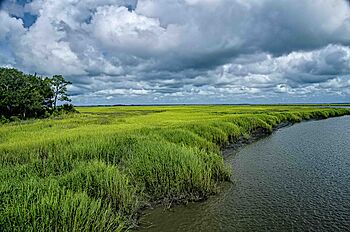Little St. Simons Island facts for kids

Salt marshes at Little St. Simon's Island, Georgia, US
|
|
| Geography | |
|---|---|
| Location | Atlantic Ocean |
| Coordinates | 31°17′56.8237″N 81°19′42.3466″W / 31.299117694°N 81.328429611°W |
| Administration | |
|
United States
|
|
| State | Georgia |
| County | Glynn County |
Little St. Simons Island is a special barrier island found off the coast of Georgia, in the United States. It's one of Georgia's Golden Isles, known for being mostly untouched by people. The island is huge, covering about 10,000 acres (40 square kilometers), and has 7 miles (11 kilometers) of beautiful beaches.
Little St. Simons Island is located near St. Simons Island and Sea Island. The Hampton River separates it from these islands. It's also separated from the mainland by Buttermilk Sound. The Altamaha River flows into the ocean just north of the island. This river helps the island grow by depositing sand and dirt.
Contents
Visiting Little St. Simons Island
This island has been privately owned since 1760. From 1908 until the late 1970s, the Berolzheimer family used it as their own private getaway. Later, they opened a special place called the Lodge on Little St. Simons.
Today, you can only reach the island by boat. If you want to visit, you need to arrange your trip through the lodge office. The Lodge on Little St. Simons offers all-inclusive stays for up to 32 guests. This means your food, activities, and a place to sleep are all included.
Fun Activities and Tours
The island has naturalists who are like expert guides. They can lead you on many exciting adventures:
- Fishing trips
- Kayaking tours
- Hiking and biking trails
- Birdwatching expeditions
- History and nature tours
You can also arrange to visit for just one day if you prefer.
Exploring the Island's Nature
Most of Little St. Simons Island is made up of salt marsh. These are wetlands that are flooded by salty ocean water. The island also has a maritime forest, which is a type of forest found near the coast.
Trees and Plants
The maritime forest is home to many different kinds of trees and plants, including:
- Cabbage palms
- Southern live oaks
- Red cedars
- Red bays
- Southern magnolia trees
- Various pine trees
Often, you'll see these trees covered in Spanish moss, which hangs down like long beards.
Amazing Birds
Little St. Simons Island is a paradise for birds! More than 334 different types of birds have been seen here. Some birds stop by during their long migrations, while others live on the island all year round.
Some of the special birds you might spot include:
Beach Life and Sea Turtles
Behind the island's beaches are untouched sand dunes. These dunes are important nesting spots for various shorebirds, like:
From May to September, the beaches of Little St. Simons Island are checked every day. This is to look for signs of loggerhead sea turtles nesting. These amazing turtles lay their eggs in the sand, and the island helps protect their babies.
Freshwater Ponds and Wildlife
The island has several freshwater ponds. These ponds are important homes for many animals:
The ponds also provide drinking water for other animals, including the European fallow deer. Fallow deer were brought to the island a long time ago for hunting. You can see them in three different colors: solid white, dark chocolate, and tan with white spots.
Ocean Animals and Fishing
If you enjoy fishing, the tidal creeks and ocean surf around the island are great places to catch fish. You might find:
- Redfish
- Black drum
- Flounder
- Speckled trout
In the waters off the island, you can also see other incredible marine animals:
- Otters
- Dolphins
- Even large right whales swimming in the inlets and the open Atlantic Ocean.
A Glimpse into History
The first owner of Little St. Simons Island was Samuel Ougspourger. He was a Swiss colonist from South Carolina. He bought the island from King George II in 1760. Eight years later, he sold it to his grandson, Gabriel Maniqualt.
Eventually, the island was bought by Pierce Butler. He had a rice plantation on the island's northwestern marsh, near the Altamaha River. Butler also hoped to grow a lot of cotton there.
A Famous Visitor
In 1839, a famous actress named Fanny Kemble visited the island. She was married to Pierce Butler's grandson. In her journal, she described the island as "a little wide sand heap, covered with thick forest growth."
Today, the island is owned by Henry Paulson, who used to be the U.S. Treasury Secretary, and his wife Wendy.


